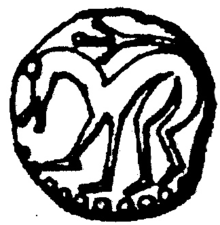
Back Ealdfriþ ANG الدفريث ARZ Aldfrith Catalan Aldfrith German Άλντφριθ της Νορθουμβρίας Greek Aldfrith Esperanto Aldfrith Spanish Aldfrith Finnish Aldfrith French Aldfrith de Northumbria Galician
| Aldfrith | |
|---|---|
 The lion symbol used on Aldfrith's coinage[1] | |
| King of Northumbria | |
| Reign | 685–704/705 |
| Predecessor | Ecgfrith |
| Successor | Disputed between Osred and Eadwulf |
| Died | 14 December 704/705 Driffield, East Riding of Yorkshire |
| Consort | Cuthburh |
| Issue | Osred Osric? Offa Osana? |
| Father | Oswiu |
| Mother | Fín |
Aldfrith (Early Modern Irish: Flann Fína mac Ossu; Latin: Aldfrid, Aldfridus; died 14 December 704 or 705) was king of Northumbria from 685 until his death. He is described by early writers such as Bede, Alcuin and Stephen of Ripon as a man of great learning. Some of his works and some letters written to him survive. His reign was relatively peaceful, marred only by disputes with Bishop Wilfrid, a major figure in the early Northumbrian church.
Aldfrith was born on an uncertain date to Oswiu of Northumbria and an Irish princess named Fín. Oswiu later became King of Northumbria; he died in 670 and was succeeded by his son Ecgfrith. Aldfrith was educated for a career in the church and became a scholar. However, in 685, when Ecgfrith was killed at the battle of Nechtansmere, Aldfrith was recalled to Northumbria, reportedly from the Hebridean island of Iona, and became king.
In his early-8th-century account of Aldfrith's reign, Bede states that he "ably restored the shattered fortunes of the kingdom, though within smaller boundaries".[2] His reign saw the creation of works of Hiberno-Saxon art such as the Lindisfarne Gospels and the Codex Amiatinus, and is often seen as the start of Northumbria's golden age.